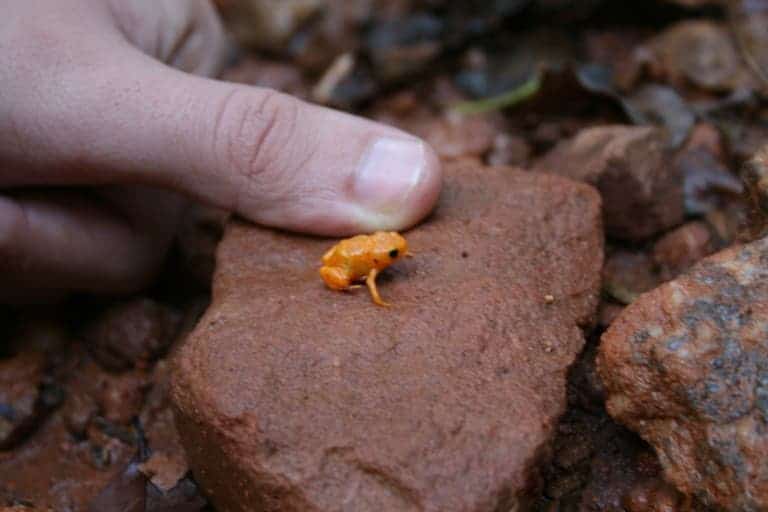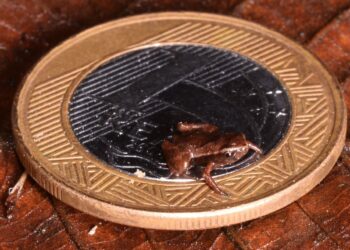Seeing a frog jump is a bit like a work of art — an enormously high leap, a controlled descent, and a solid landing — most frogs have truly mastered the art of jumping. But not the pumpkin toadlet. The pumpkin toadlet (Brachycephalus ephippium) is so ridiculously bad at jumping that for quite some time, it had biologists wondering how it can even survive. To make matters even more curious, this frogs’ ears are so underdeveloped that it can’t even hear its own mating advertisement calls. Now, a team of researchers believe they’ve figured out what’s going on with these frogs.

The brightly colored species of frog lives on the leaf floor of the Atlantic Amazon, at altitudes of 200–1,250 m (660–4,100 ft). It measures only around 5 mm (0.2 inch) and mostly feeds on tiny invertebrates like insects or spiders. But that’s not what’s weird about them.
Pumpkin toadlets are not only bad at jumping; slow-motion videos show that they make no attempt to reorient themselves after jumping into the air, and instead, they just crash-land into whatever surface they encounter. This type of behavior is not only unusual (some frogs can jump more than ten times their body length and land perfectly), it’s actually dangerous.
How could a frog, a quintessentially good jumper, be such a klutz?
A team of researchers from the US and Brazil wanted to get to the bottom of things. They suspected that the problem isn’t with the frog’s muscles or coordination, but rather with its sensory ability.
Some other frog families (like frogs from New Zealand, for instance) also don’t control their landing when jumping, but the pumpkin toadlet isn’t related to them at all. Its relatives are good jumpers — and good landers. But its relatives are also a bit larger.

The pumpkin toadlet has the smallest inner ear canals of all the 147 frogs analyzed in the new study. The inner ear canal isn’t just important for hearing, but also for balance. It is semicircular in shape and filled with liquid, and as the animal moves or jumps about, the liquid also moves, stimulating the nerve cells that line the canal and fueling a sense of balance.
If the canal gets too small, then the liquid contains less fluid and has a much more difficult time moving around — and as a result, the animal never feels a sense of balance when jumping. The idea that this mechanism is at work is also backed up by high-speed camera footage, which showed that pumpkin frogs have very few changes in their rotation speed when they jump. Basically, they don’t even try to adjust their position. This is similar to what other frog species do when their inner canal is damaged or impaired.
This obviously puts them at a disadvantage compared to other frogs, but because the species still exists, researchers suggest that it must have developed other advantages such as camouflage, thicker skin, and even toxic skin.
Pumpkin toadlets feature several other quirks. They don’t have a tadpole stage, and they lay eggs on land that hatch directly into young toadlets. In 2019, a study also found that their heads and backs glow under ultraviolet light, due to their fluorescent skeletons. This feature could be related to their mechanisms for picking mates, as it seems to be unrelated to predation, and given that the frogs have a hard time hearing their own mating calls, it could be a way to find suitable mates.

Journal Reference: Richard L. Essner et al, Semicircular canal size constrains vestibular function in miniaturized frogs, Science Advances (2022). DOI: 10.1126/sciadv.abn1104






